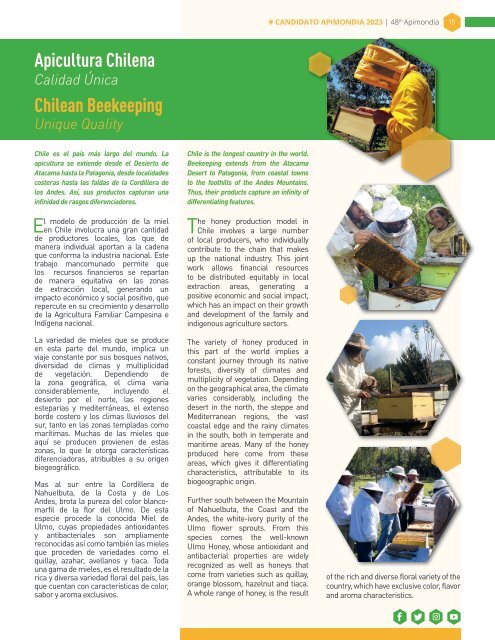Revista Apimondia En Chile
Create successful ePaper yourself
Turn your PDF publications into a flip-book with our unique Google optimized e-Paper software.
# CANDIDATO APIMONDIA 2023 | 48 th <strong>Apimondia</strong><br />
15<br />
Apicultura <strong>Chile</strong>na<br />
Calidad Única<br />
<strong>Chile</strong>an Beekeeping<br />
Unique Quality<br />
<strong>Chile</strong> es el país más largo del mundo. La<br />
apicultura se extiende desde el Desierto de<br />
Atacama hasta la Patagonia, desde localidades<br />
costeras hasta las faldas de la Cordillera de<br />
los Andes. Así, sus productos capturan una<br />
infinidad de rasgos diferenciadores.<br />
El modelo de producción de la miel<br />
en <strong>Chile</strong> involucra una gran cantidad<br />
de productores locales, los que de<br />
manera individual aportan a la cadena<br />
que conforma la industria nacional. Este<br />
trabajo mancomunado permite que<br />
los recursos financieros se repartan<br />
de manera equitativa en las zonas<br />
de extracción local, generando un<br />
impacto económico y social positivo, que<br />
repercute en su crecimiento y desarrollo<br />
de la Agricultura Familiar Campesina e<br />
Indígena nacional.<br />
La variedad de mieles que se produce<br />
en esta parte del mundo, implica un<br />
viaje constante por sus bosques nativos,<br />
diversidad de climas y multiplicidad<br />
de vegetación. Dependiendo de<br />
la zona geográfica, el clima varía<br />
considerablemente, incluyendo el<br />
desierto por el norte, las regiones<br />
esteparias y mediterráneas, el extenso<br />
borde costero y los climas lluviosos del<br />
sur, tanto en las zonas templadas como<br />
marítimas. Muchas de las mieles que<br />
aquí se producen provienen de estas<br />
zonas, lo que le otorga características<br />
diferenciadoras, atribuibles a su origen<br />
biogeográfico.<br />
Mas al sur entre la Cordillera de<br />
Nahuelbuta, de la Costa y de Los<br />
Andes, brota la pureza del color blancomarfil<br />
de la flor del Ulmo. De esta<br />
especie procede la conocida Miel de<br />
Ulmo, cuyas propiedades antioxidantes<br />
y antibacteriales son ampliamente<br />
reconocidas así como también las mieles<br />
que proceden de variedades como el<br />
quillay, azahar, avellanos y tiaca. Toda<br />
una gama de mieles, es el resultado de la<br />
rica y diversa variedad floral del país, las<br />
que cuentan con características de color,<br />
sabor y aroma exclusivos.<br />
<strong>Chile</strong> is the longest country in the world.<br />
Beekeeping extends from the Atacama<br />
Desert to Patagonia, from coastal towns<br />
to the foothills of the Andes Mountains.<br />
Thus, their products capture an infinity of<br />
differentiating features.<br />
The honey production model in<br />
<strong>Chile</strong> involves a large number<br />
of local producers, who individually<br />
contribute to the chain that makes<br />
up the national industry. This joint<br />
work allows financial resources<br />
to be distributed equitably in local<br />
extraction areas, generating a<br />
positive economic and social impact,<br />
which has an impact on their growth<br />
and development of the family and<br />
indigenous agriculture sectors.<br />
The variety of honey produced in<br />
this part of the world implies a<br />
constant journey through its native<br />
forests, diversity of climates and<br />
multiplicity of vegetation. Depending<br />
on the geographical area, the climate<br />
varies considerably, including the<br />
desert in the north, the steppe and<br />
Mediterranean regions, the vast<br />
coastal edge and the rainy climates<br />
in the south, both in temperate and<br />
maritime areas. Many of the honey<br />
produced here come from these<br />
areas, which gives it differentiating<br />
characteristics, attributable to its<br />
biogeographic origin.<br />
Further south between the Mountain<br />
of Nahuelbuta, the Coast and the<br />
Andes, the white-ivory purity of the<br />
Ulmo flower sprouts. From this<br />
species comes the well-known<br />
Ulmo Honey, whose antioxidant and<br />
antibacterial properties are widely<br />
recognized as well as honeys that<br />
come from varieties such as quillay,<br />
orange blossom, hazelnut and tiaca.<br />
A whole range of honey, is the result<br />
of the rich and diverse floral variety of the<br />
country, which have exclusive color, flavor<br />
and aroma characteristics.


